Clay is an exciting medium and never fails to intrigue and excite children of all ages. I love to see faces light up when young people are handed a block of stoneware at the beginning of a project, and see the amazement when you simply slice a block with cut-off wire to reveal that flat, smooth clean edge.
I am lucky; I started my teaching career in 1994 with Glyn Thomas at Kenton School, Newcastle-upon-Tyne, where ceramics was strong and celebrated. Glyn and his team have sent many excellent ceramicists onto higher education, including Stuart Carey, but over the years we have seen how the Arts in schools, particularly traditional crafts, have been in decline. I hear stories of whole ceramics departments shutting down due to the scale, space and running costs needed to sustain courses in universities and colleges; not to mention the expertise needed to manage kilns, pug mills, slab rollers and wheels. Teachers do worry about where clay is going but I know there are schools and colleges in the UK who, like us, have a passion for clay.
What is happening to the craft of clay? How many schools are still using potters wheels? If courses are not available what is the point in continuing to teach children these skills? Why? Because children love handling clay. They want to squeeze it and experiment with shape and form. They want to see it ooze between their fingers. They want to give it a good bash on the desk. They are liberated, energised and excited by its possibilities.
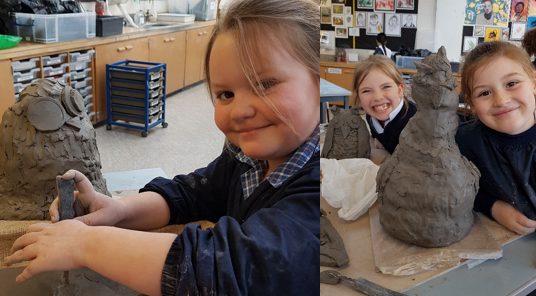
Junior School Year 4 Owls from 2019, Constructed through Slabs and Coils.
My department are experienced enough to know that allowing the girls to independently explore their ideas is going to lead to fantastic sculptures. We plan and lead projects across our Junior and Senior School, and in particular, the last two years have been busy for us with a range of hand building projects taking shape. We find our sources of inspiration from surprising starting points and impromptu discussions in the department. Hand built animals are always popular, and we like to explore cultures through clay, examples include Egyptian Canopic Jars, Islamic Tiles and Native American Totems.
Researching projects is a fantastic element of Art, Craft and Design teaching and Karen Bull, who studied Ceramics and Glass at Cardiff, spends her valuable technician time creating exemplar sculptures as teaching aids, in addition to team teaching with Nieldre Laubscher and myself. She is very much at the forefront of the department, not just the mysterious figure loading the kiln at the back of the classroom. The girls know her.
Clubs such as Polymer Clay have popped up with students in Year 8 leading these sessions during their lunchtime, continuing their love of 3D work. This group of girls then formed a business venture through one of our Business Studies teachers, Imogen Tansley. The Tenner Challenge is a national competition – ‘Clay Create’ made a healthy profit after successful sales from stalls and markets.
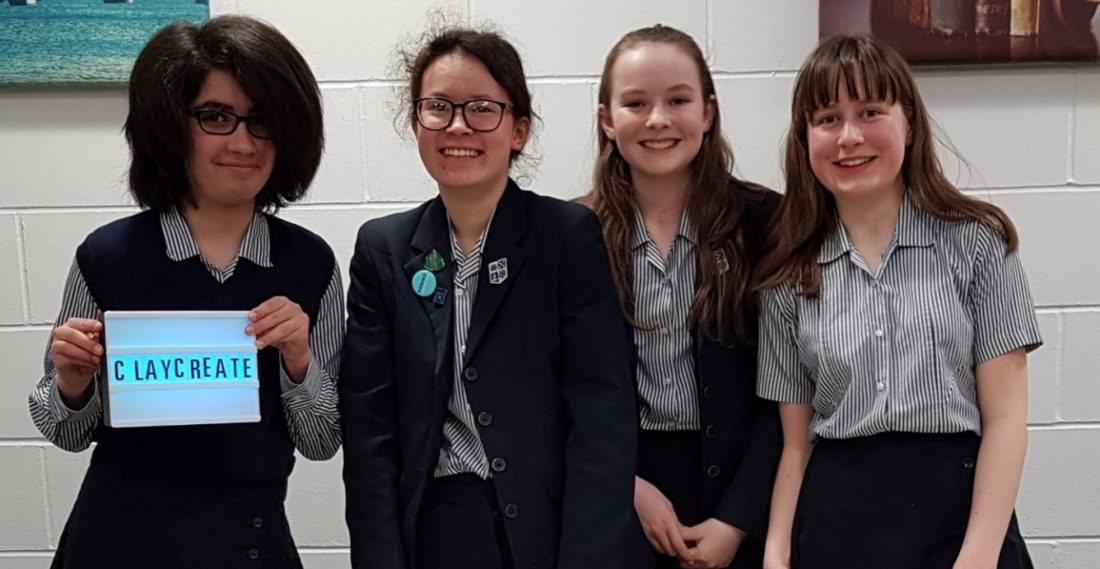
‘ClayCreate’ Year 8 Students (Ariana, Mia, Annie-May and Lois).
Ceramics and working with clay is enjoyed by students of all ages, and we love giving our pupils the chance to be creative and see their ideas come to life. They love to use their imagination, and express themselves with different methods and techniques, to create a final product to be proud of and celebrate. This is the case across the whole of the school, with methods of study and practical tasks progressing as students grow, as you will see below.
A Level student Freya visited Kew Gardens and she was inspired by the glass art installation of Dale Chihuly. She wanted to use clay on a larger scale within a designated space, as opposed to creating a small sculpture, vessel or ornament. She examined curves, rhythms and repetition, before sketching and planning her interior space in The Studio. Additionally, she has made prototypes and support work in paper and card, experimenting with colour and monochromatic pieces.
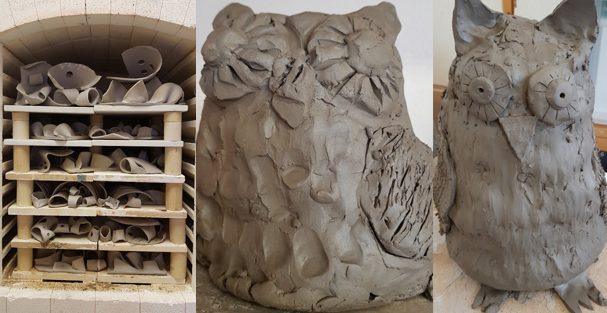
Left: A Level work in progress. Component parts ready for larger ceramic installation.
Right: Year 4 Owls in Progress. Showing use of hands and modelling tools to achieve texture.
In our Junior School, Year 4 students have taken up the enjoyable task of creating clay owls. Starting with a block of clay, we used various wooden and metal tools, along with knives to refine and develop owl shapes and features, but we talked to pupils about our hands being the best for sculpting. The pupils quickly learned the importance of balance, use of slip and the drying out process before firing.
In Year 8, one exciting task our students undertook during the summer term was to create Islamic designs using traditional terracotta clay. Groups consulted traditional Islamic patterns and symmetry before creating their tiles, which the students carved with wooden and metal tools, incised with knives or built up with raised slabs to create a variety of designs and finishes. Card and paper templates ensured high quality results.
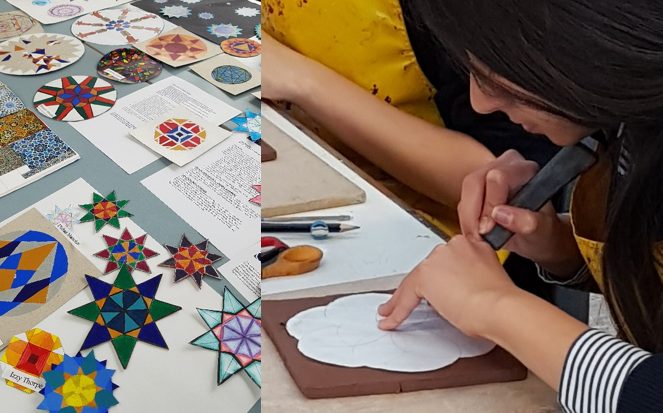
Islamic designs, ready for tile construction, using traditional terracotta clay for authenticity.
Students in Year 9 had great fun creating Club Tropicana inspired plates. Using slabs and underglazes for colour, old plates were used as moulds for the ease of construction and to give a smooth finish, with the finished items being displayed proudly at the front of the school. A recent task for our Year 10 students was to plan and create their own Canopic Jars. Using the coil technique to hand build the structure, the final results were fantastic as you will see below.
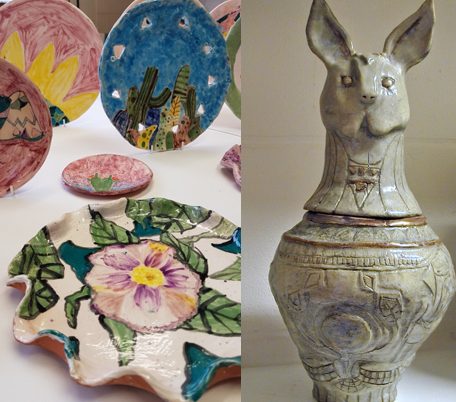
The finished results of our Year 9 Club Tropicana plates and the Year 10 Canopic Jars
One of our recent projects was ambitious in both number and scale, with us transforming our Senior School foyer to represent an ocean bed ceramic installation. 71 Year 8 students looked at a range of artists including Ernst Haeckel and Kate Malone, to inspire shapes and forms for their sculptures. Sea sponges, urchins, coral and kelp all provided ideas for the girls to express themselves through slabs, coils and hollowing out solid shapes.
Our intention was to provide our visitors not just with a decorative ocean bed, sweeping underneath our large open stairways, but to share a social comment on plastic in our oceans and the need for this to cease. Upon further inspection, the audience could see the plastic remnants we place in our installation and read the statistics and the action taken to stop this plastic pollution. Eco bricks created and donated by our school community and Eco Team, led by Head of Humanities, Mr Earp, will form part of the installation.
As we return to school, many new exciting projects are underway across all areas of the arts. We are excited to share our progress, and we invite you to head to our Twitter page (@ArtsNHS) where you will find a plethora of media showcasing our students’ outstanding work.
Mrs Mel Beacroft
Head of Creative Arts Faculty